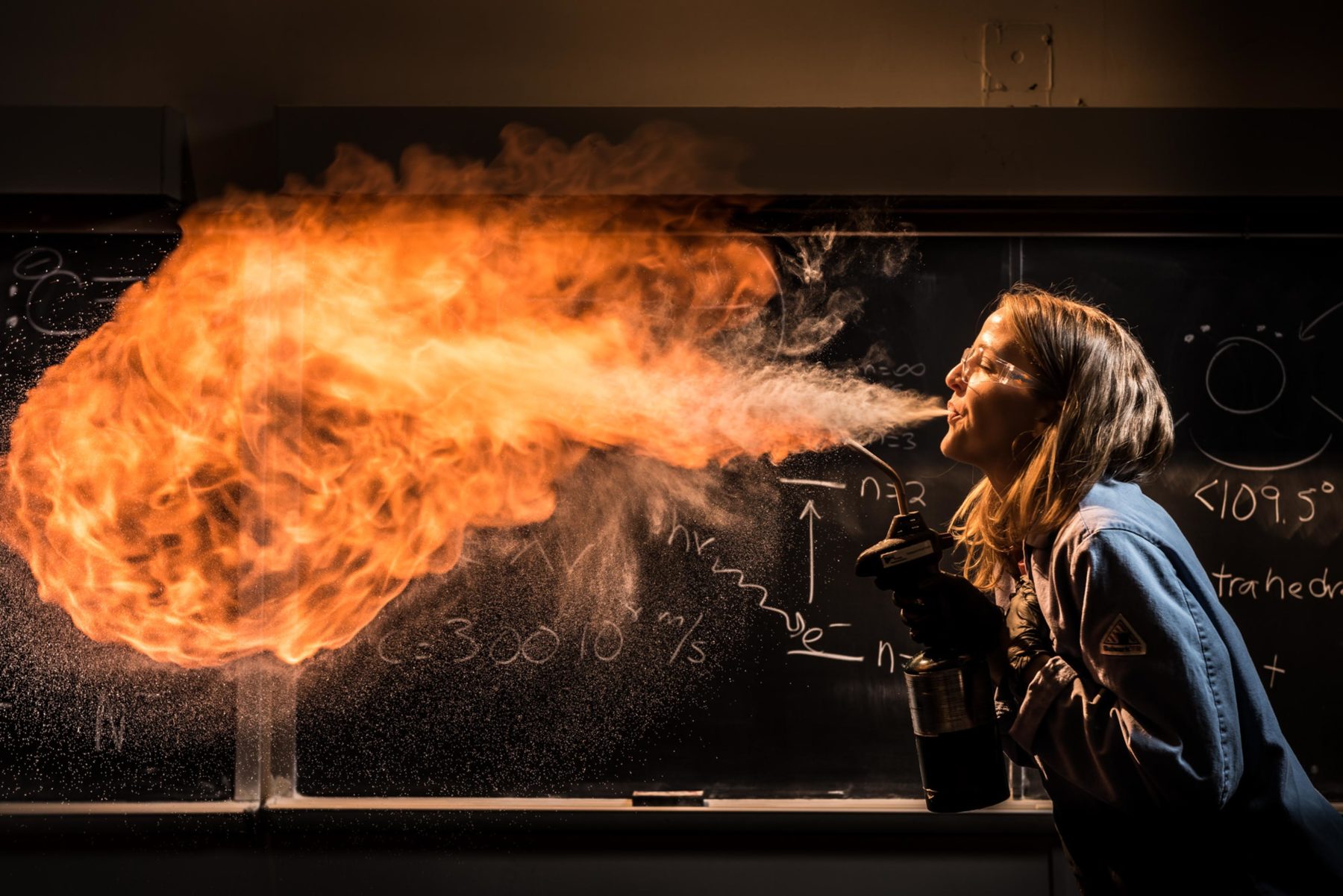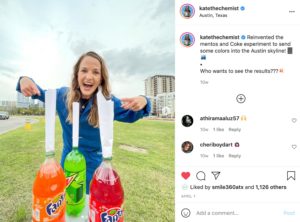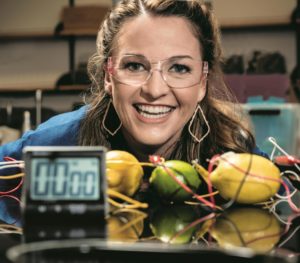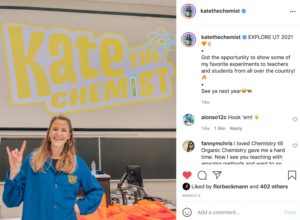Kate the Chemist: Professor, Science Entertainer and Self-Proclaimed Pyromaniac

The first time Dr. Kate Biberdorf realized that she might really be on to something in the science communication realm was at the beginning of a new school semester. On the first morning of classes, instead of the typical filing in of students for her 8 a.m. chemistry lecture, there was a line of students waiting their turn to take a selfie with her — at 7:50 a.m., before she had even introduced herself or the class.
“I was absolutely gobsmacked,” Biberdorf remembers. “And my TA (that I’ve worked with for years) could not stop laughing at my shocked [and] confused expressions.”
With book deals, appearances on major shows (like when she breathed fire with Stephen Colbert) and all kinds of speaking gigs under her belt, it’s safe to say that Biberdorf is making some big waves in the field.
It’s no surprise either once you see her bubbly, enthusiastic explanations and demonstrations that light up the room even before the explosions and fire erupt. Her gusto is alluring and her smile is contagious as she walks the crowd, classroom or audience through each experiment.

The Beginning
How did Biberdorf evolve into this unique and sensational chemistry professor, leader and inspiration for women and girls across all disciplines? To explain it all, one has to start at the beginning, with the little girl growing up in a small town in Michigan.
Even before her first chemistry class, the young Dr. Biberdorf found herself fascinated with the natural wonders of the world. Her parents, both psychologists, fostered and encouraged that curiosity within her and her sister throughout her childhood, even explaining and instilling in them psychology theories of education and learning.
Then, in her sophomore year of high school, she was finally introduced to chemistry.
“My chemistry teacher, Mrs. Kelli Palsrok, was so passionate about the sciences,” Biberdorf says. “She made me fall in love with chemistry.”
In that classroom, her passion for chemistry was ignited in the same way her experiments so often do — with a big, beautiful bang. She knew then that she was going to be a chemist.
She once said in an interview with the National Science Foundation that there was another key moment during her childhood that likewise shaped her love for teaching. In the video, she shares a story of when she was helping her sister with her homework. Seeing the confidence that a “light-bulb moment” can foster in someone, it became one of the driving forces for pursuing a career as a teacher.
So, she set off to study chemistry all the way through to completing a Ph.D. at the University of Texas at Austin where she then received an associate professorship. Armed with a fervent passion for science and an understanding of educational psychology through her parents, Biberdorf quickly began making her mark.
The Technique

Photo by Dustin Meyer.
In the classroom, Biberdorf utilizes several education theories, the first being the VARK model of learning. This is the idea that there are four main types of learners: visual, aural, readers and kinesthetic. Each student is a different kind of learner and grasps concepts easier when taught in that specific style.
“I do my best to make sure that I’m always presenting the material in all four manners,” Biberdorf explains. “I offer textbook readings for my reader learners, lengthy explanations in lecture for my aural learners and then the big experiments are for my visual/kinesthetic learners.”
This across-the-board style of teaching doesn’t go unnoticed. Kristin Bova, a former student of Biberdorf’s Chemistry II class, says that, although Chemistry I and II were just requirements for her degree, she found herself excelling in the class even though it’s supposed to be much more difficult than Chemistry I — a class she says was not her strongest.
“Since I was able to do so much better in Chemistry II, it made me realize that it wasn’t me, it was just the way the other teacher taught,” Bova says.
Then, Biberdorf’s signature explosions and fire-breathing come in as a response to William James’ theory of emotional memory. This is the idea that, when there is an emotional response, it becomes easier and more likely for the brain to create that experience as a memory.

“Therefore, if my students respond to a giant fireball emotionally, then I have about 60 seconds [after] to teach them a new chemistry topic,” Biberdorf says. “Plus, who doesn’t like to breathe fire? It’s just more fun to teach this way.”
The Growing Fame
Although Biberdorf thought she’d only be a professor, about seven years ago a colleague asked her to help him with a brief segment on the variety show We Are Austin. That was the first domino that started the rapid succession of TV segments that led to her career as a public figure and a leader in STEM outreach.
That first segment went so well that the show kept asking her back until pretty soon she was a frequent guest there and at several other stations in Austin and around Texas. That’s when she landed a partnership with Amy Poehler’s Smart Girls, which led to the likes of NBC Nightly News, The Kelly Clarkson Show, The Wendy Williams Show and The Late Night Show with Stephen Colbert wanting in on the STEM action.
All the while, she was perfecting her art — and her teaching performance truly is an art.
What’s Next
With the close of her seven-book deal with Penguin Random House that included the fiction series “Kate the Chemist” and the two at-home experiment recipe books, Biberdorf already has another book on the way. Titled “It’s Elemental,” the book comes as her first adult non-fiction book that walks you through the chemistry of everyday life.
Biberdorf says she also has some super exciting projects in the works, but her dream gig looks a little different.
“My dream job would be to have a huge science show in Vegas, where families could go out in the evening (and maybe learn a few things along the way),” Biberdorf says. “I’m obsessed with the theatrics of the Vegas shows, and I think we could do something really spectacular with fire-throwing and liquid nitrogen explosions!”






